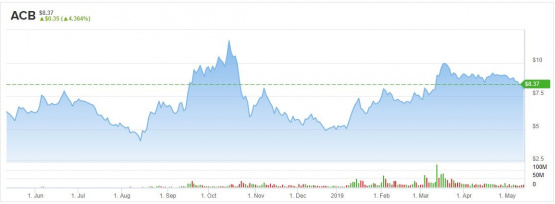All Eyes on Aurora Cannabis (ACB) Stock Ahead of Earnings This Evening

Today after the market closes, Aurora Cannabis (ACB) is set to report FQ3 numbers for the March quarter. The numbers are crucial as they provide insight into the troubling sales of legalized cannabis in the Canadian adult-use market. With all data points suggesting weak legal sales, the company has a high hurdle to match analyst estimates for sequential revenue growth.
Downside Risk
Analysts forecast Aurora to lose 50 cents per share on revenue of C$67.5 million. The company generated net revenues of C$54.2 million and net cannabis revenue of C$47.6 million in the December quarter and lost a substantial C$238 million due to investment losses.
The risk here is to the downside with reported monthly sales in Canada remaining relatively flat. The only revenue growth is likely to come from recent acquisitions like Whistler Medical Marijuana Corp. that closed during the March quarter.
A couple of key figures for the quarter are the gross margin and the average net selling price. In FQ1, Aurora saw the gross margin dip to 54% and the selling price for dried cannabis fell 26% sequentially to C$6.23 per gram. Any weakness here is problematic for the stock.
The lack of organic growth would normally crush a pricy stock, but the stock market is likely to still latch onto high hopes for the global cannabis market.
High Hopes
The question Aurora needs to answer for investors is what happens with the additional supply hitting the market this quarter. The large cannabis company has long projected reaching an annual production rate of 150,000 kg by the end of March.
Due to the time period for the cannabis supplies to reach the market, Aurora forecasts 25,000 kgs available for sale in the June quarter. The number is 3.5x the 6,999 kgs sold in the December quarter while demand is not growing due in large part to the illegal market.
Along with the forecast for the higher production and sales level, management promoted the concept of Aurora being EBITDA positive in the June quarter. With the quarter halfway over, the risk is that management has to walk back this target due to lackluster sales and prices.
Aurora raised their total projected capacity from 500K kg to 625K kg back in early April, which it expects to reach my mid calendar 2020. A big question remains the justification of increasing planned capacity by 25% without any sign that all of the existing cannabis capacity will be absorbed. Any failure to explain this corporate decision could weigh on the stock.
Some potential upside comes from Ontario opening up additional retail stores after having an initial restriction of retail stores and the consumables market opening up in October. The addition of vapes, edibles and beverages will open up new revenue streams currently restricted, but the company has a lengthy period to transition to these new products.
Takeaway
The key investor takeaway is that Aurora stock is in a precarious position where the company will have a difficult time maintaining previous lofty projections. With about 1.1 billion shares outstanding, the stock still has a market value of ~$9 billion despite the dip to multi-months lows at $8.
The risk is to the downside, if management confirms some of the worst fears regarding pricing, mounting losses and wild capacity expansion. The likely outcome is that Aurora stock still spins a bullish market thesis due to global expansion and the further opening up of the domestic Canadian cannabis market. The market likely gives the stock a pass on weak results.
To read more on the nitty gritty of what’s going on in the rising cannabis industry, click here.
Read more on ACB:
- Aurora Cannabis (ACB) Stock Is Still a Buy, Says Analyst
- M&A to Save Aurora Cannabis (ACB) Stock in the End
- The Cannabis ‘Magic Bus’ Is About to Leave the Station! Next Stops? Aurora Cannabis (ACB)
More recent articles from Smarter Analyst:
- Top Analyst Remains Bullish on Alibaba (BABA) Stock Ahead of Earnings
- Nvidia (NVDA) Stock: Short-Term Pain, Long-Term Gain?
- Aurora Cannabis (ACB) Stock Is Still a Buy, Says Analyst
- All Eyes on Aurora Cannabis (ACB) Stock Ahead of Earnings Today